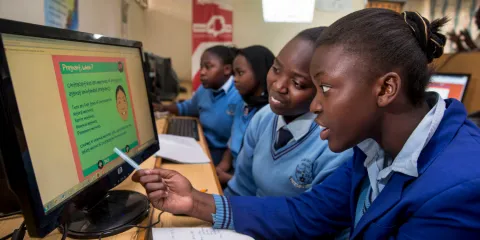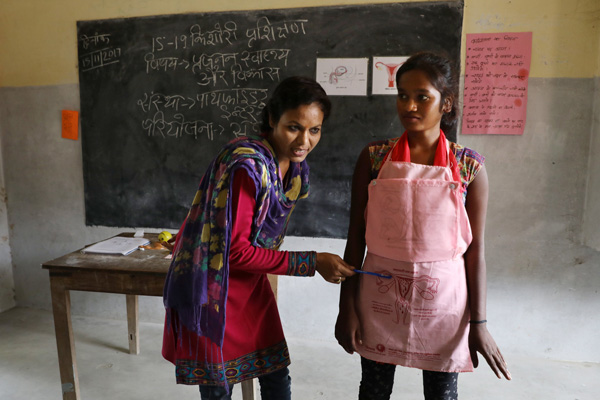Day of the Girl: Equity, health and the SDGs

Today is International Day of the Girl Child, which is about recognising the rights of girls and the unique challenges they face around the world.
While we’ve seen great gains in gender equity, there’s still a way to go as millions of girls continue to face disadvantages as it relates to their physical and mental health, rights, and education – simply because of their gender.
Women and girls – hardest hit by poverty
Many of these disadvantages stem from the fact that girls and women are hit hardest by poverty – which is increasing because of COVID-19. A recent analysis from the United Nations University reported that after 30 years of declining poverty, the pandemic could increase global poverty by 8% from 2020.
For girls in low- and middle-income countries (LMICs) and in homes with limited resources, poverty means that they often get less food, are less likely to access healthcare, and receive less education than boys. This can significantly impact their educational attainment, economic potential and ability to lead a healthy life.
Around the world, 700 million fewer women than men are in paid work, while the burden of unpaid work falls mainly on women and girls – which includes childcare, caring for sick or disabled family members, and housework.
Increasingly, families are trapped in or driven into poverty through catastrophic health expenditures and income loss because of chronic conditions like diabetes, cancer, heart, and lung disease. The burden of these noncommunicable diseases (NCDs) is greatest in LMICs, where 77% of 41 million global deaths occur.
The education of girls is also threatened or disrupted as they are more likely to take on the role of caregiver for family members living with chronic conditions. Families affected by poverty may feel forced to remove girls from education to save money.
Despite the great progress that’s been made to achieve gender parity in primary education, as many as 48% of girls remain out of school in some regions, and 15 million girls worldwide are not enrolled in primary education compared to 10 million boys. After school closures due to the COVID-19 pandemic, it is estimated that an additional 11 million girls will never return to school.
This means lost opportunities for girls and an increased risk of violence, exploitation, and early marriage. Today, one in five marriages involves a child bride. And as a result of the pandemic and its poverty-generating effects, up to 10 million more girls are at risk of becoming child brides by 2030.
Women and girls – the triple health burden
Women and girls, particularly in LMICs often face a triple burden of reproductive and maternal health conditions, infectious diseases, and noncommunicable diseases, which combine and interact leading to poor health.
This is particularly true during their adolescent years which can be a vulnerable time for girls – with increased exposure to sexual health issues and other behavioural risk factors for NCDs.

Often, women and girls do not have access to vital information and education on the importance of screening for diseases, even when there are no signs and symptoms of disease present. They may not even be able to access this type of care because of social determinants of health like illiteracy and low socio-economic and political status, which limit the ability of women to inform and protect themselves against NCDs, infectious diseases like HIV and other chronic conditions.
Prevention, screening and health services need to be context-specific and highly tailored to meet diverse needs of women and girls throughout their lifetime. throughout women and girls through their lifetime. Integration of NCD prevention and control efforts within existing health services is increasingly necessary to bolster progress in women’s health and socioeconomic well-being.
Equality and the SDGs
The 2030 Agenda for Sustainable Development and its 17 Sustainable Development Goals (SDGs) adopted by world leaders in 2015 are intended to serve as a roadmap for sustainable progress that leaves no one behind. Achieving gender equality and empowerment of girls and women is integral in some way to each of these 17 goals. Along with SDG 1 (No poverty) and SDG 4 (Quality education), here are just a few more ways that gender inequity is standing in the way of achieving the SDGs:
- SDG 2 Zero hunger: Food insecurity levels were 10% higher among girls and women than boys and men in 2020. In some parts of the world, over 10% more women are moderately or severely food insecure than men.
- SDG 3 Good health and well-being: Just 17 of 176 countries are expected to achieve target 3.4 for women, to reduce premature deaths from noncommunicable diseases by one-third by 2030.
- SDG 5 Gender equality: At the current rate of progress, it may take another 286 years to remove discriminatory laws and close gaps in legal protections for women and girls.
- SDG 7 Affordable and clean energy: Household air pollution from cooking and heating fuels cause an estimated 3.2 million deaths each year and nearly half of all deaths due to lower respiratory infection among children under 5 years of age - almost all of these in low- and middle-income countries. As girls and women spend more time in the home, they bear the greater burden of these deaths and illnesses.
- SDG 16 Peace, justice and strong institutions: As of July 2022, only 27 countries (14%) have a woman as head of state and/or government. According to the latest available data, women comprise just 26% of parliamentarians globally and 34$ of local government representatives. In decision making, we are far from achieving gender parity.
For a society to truly be healthy and prosperous, all members of that society must have equal rights. Women and girls represent half of the world’s population and, therefore, also half of its potential. Gender inequality holds many girls and women back, and this holds our world back. Today’s girls are tomorrow’s women - they are the key to eliminating gender inequality.